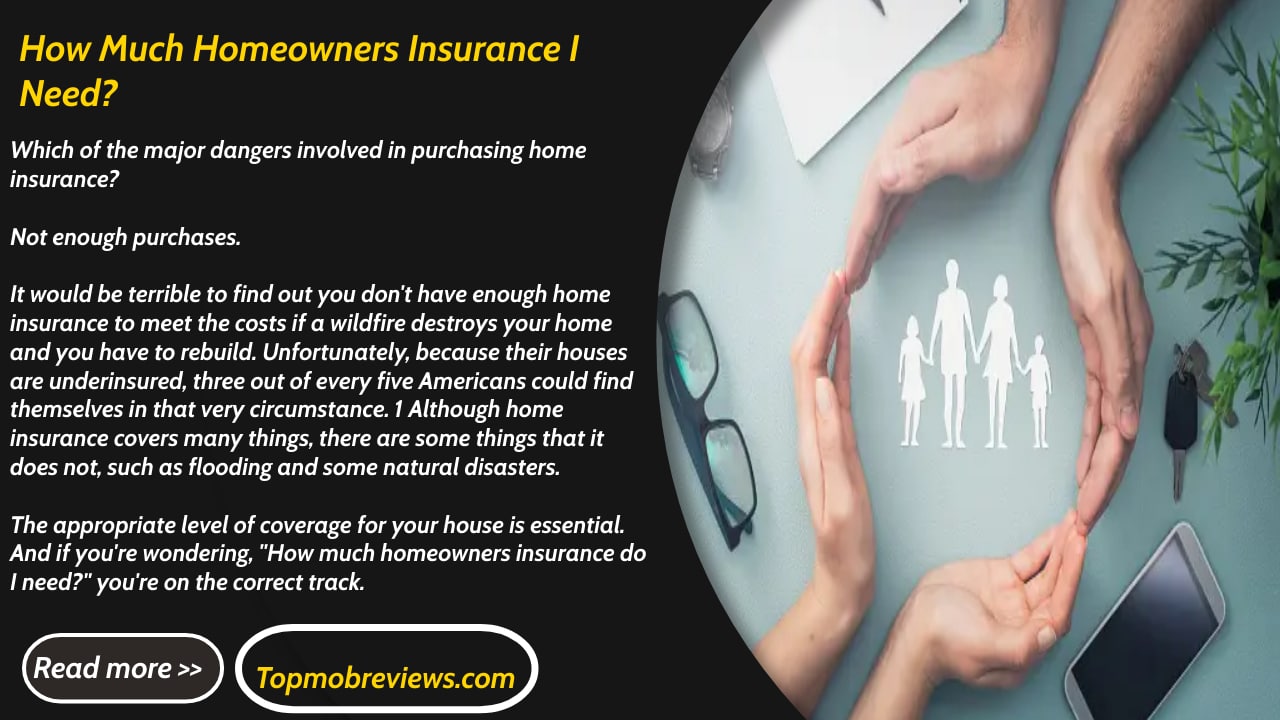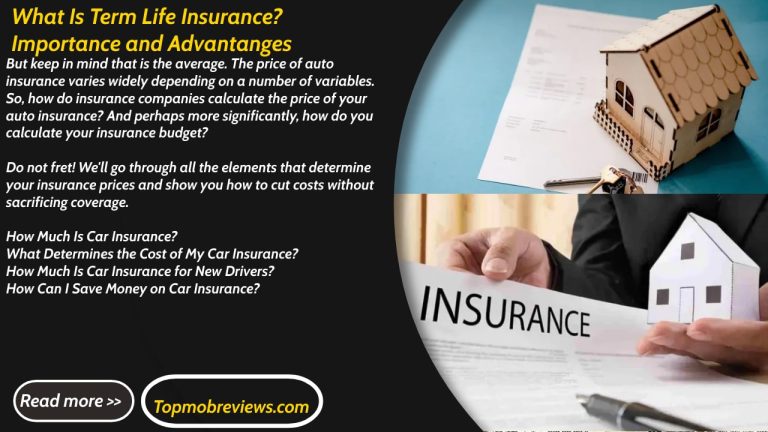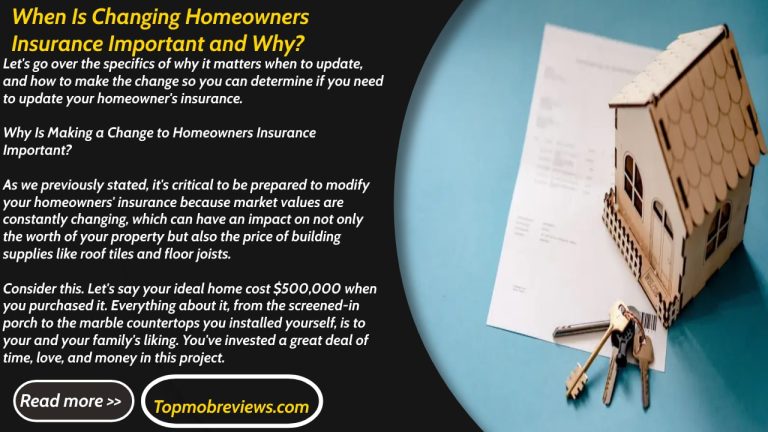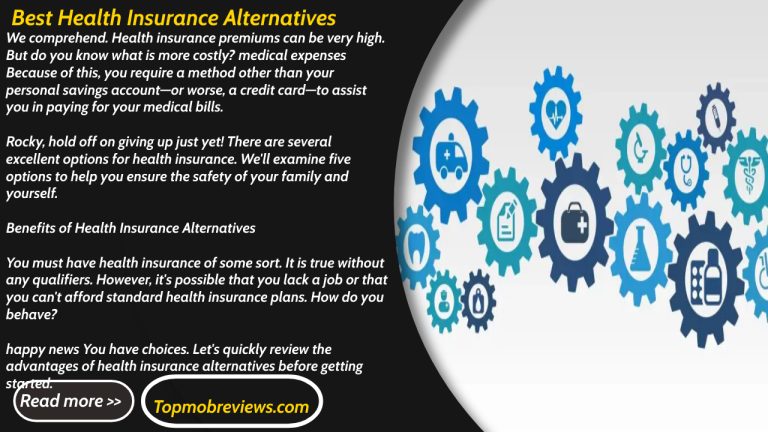How Much Homeowners Insurance I Need?
Which of the major dangers involved in purchasing home insurance?
Not enough purchases.
It would be terrible to find out you don’t have enough home insurance to meet the costs if a wildfire destroys your home and you have to rebuild. Unfortunately, because their houses are underinsured, three out of every five Americans could find themselves in that very circumstance. Although home insurance covers many things, there are some things that it does not, such as flooding and some natural disasters.
The appropriate level of coverage for your house is essential. And if you’re wondering, “How much homeowners insurance do I need?” you’re on the correct track.
To protect your biggest investment, I’m here to assist you to figure everything out.
In essence, you need enough homeowner’s insurance to
- Renovate your house (extended dwelling coverage)
- Change your belongings (personal property)
- Injuries and property damage are covered by insurance (liability)
- After the loss of an insured house, pay back your living expenses (additional living expenses)
Check your insurance declaration page if you already have homeowners insurance but are unsure of how much coverage you have. This is a great helpful explanation of what you are paying for from your insurance company.
- How much dwelling coverage should you have?
- How do you calculate the replacement cost?
- How much personal property coverage should you have?
- How can you calculate the cost to replace your stuff?
- How much liability coverage should you have?
- Should you get Additional Living Expenses (ALE) coverage?
How Much Homeowners Insurance Do I Need?
First and foremost, you need to purchase the appropriate sum of homeowners insurance for, well, your home. Additionally, you are actually required to carry a minimum amount of liability and home insurance if you have a mortgage. (Check out our free Home Buyers Guide if you’re looking into homeowners insurance because you’ve just started looking for a home. It provides all the information you require regarding a process that can occasionally be quite difficult.)
In the event that your house burns destroyed, collapses in a storm, or explodes without notice, dwelling coverage guarantees to reconstruct it. Think about the structure of your home, all the materials used to create it, and anything attached to it, such as a garage, deck, or front porch, when you hear the term “dwelling coverage.”
How much do you need?
It should go without saying that your housing coverage should be equal to the replacement cost of your home, or the sum necessary to erect a home that is an exact replica of yours.
Without a doubt, your home needs replacement cost insurance.
How do you calculate the replacement cost?
It can be challenging to determine the replacement cost. However, it’s up to you to do it right, so follow these three steps to make sure your estimate is accurate.
First, multiply your home’s square footage by the cost of construction in your area. These prices can be found on the websites of the majority of construction businesses, or you can contact an impartial insurance agent to estimate them for you.
Get a second estimate by using an online calculator after that. There are free online estimators that use the square footage, type of construction, and a number of rooms in your house to provide you with a reliable replacement cost estimate.
Third, after obtaining your own estimate, request a professional’s opinion. An expert independent insurance agent who is familiar with the region, like one of our recommended professionals, will be able to provide you with a highly accurate replacement cost estimate.
What factors affect the replacement cost?
Once you have an exact replacement cost, you should review it every few years. To do that, be sure to keep an eye out for these five replacement cost-influencing elements.
1. New building codes that were set up after your home was built
If a natural disaster destroys your current home, you might have to pay for additional safety features because your new home will need to adhere to current building rules. Ask your insurance agent if you can add “building code coverage” to your policy so that they will pay for anything the new codes need. Insurance companies occasionally offer this service.
2. Remodeled kitchens
Kitchens are the heart of the home, so it makes sense that remodeling them might affect the value of a property. Whatever improvements you’ve made—quartz or granite countertops, double tub stainless steel sinks, resilient flooring—adjust your homeowner’s insurance to reflect the rise in the worth of your house.
3. Additional rooms and structures
Maybe as your family developed, you decided to finish your attic to provide more bedrooms. A garage, a workshop, or a screened-in porch might also have been added. The value of new rooms increases, and you run the danger of having to pay for them again if your home’s insurance is not updated to reflect these improvements. Nobody desires that.
4. Rising prices of building materials and construction costs
Bricks, wood, and stone gradually increase in price, particularly if a natural calamity has destroyed a portion of your town, increased demand, and reduced supply. Construction expenses frequently increase along with building supplies as well as labor wages.
A product referred to as guaranteed replacement cost coverage is offered by several insurance companies. They will pay for the replacement of your home regardless of how much the cost of construction has increased, which is exactly what it says on the tin.
The finest insurance you can purchase is guaranteed replacement cost coverage since it ensures coverage for every conceivable scenario. However, it can be challenging to acquire this caliber of superior coverage, and many businesses don’t even provide it.
However, most businesses do provide a useful choice known as extended replacement cost. It increases the amount of coverage you have by a fixed percentage, ranging from 25% to 100%. Even a 25% payout extension is nothing to be ashamed of, but you should always aim for 100%, which is the optimal proportion.
5. Old and hard-to-replace features
“They’re not made as they used to be,” Yes, it is correct. The number of carpenters skilled in creating ornate ceiling moldings and arched windows fluctuates over time along with changes in building styles. You could have to pay more to replace specific elements in your home, particularly if they call for skilled craftsmanship.
How much coverage should you have for personal property?
Let’s acquire coverage for your possessions, or what most homeowner insurance policies refer to as personal property coverage, now that your home’s structure is covered.
Your furniture, appliances, clothing, sports gear, electronics, and even the food in your refrigerator are all considered personal property. (This protection is after all private.) It protects your belongings if they are damaged, taken, or vandalized.
How Much Personal Property Coverage Should You Have?
To replace all of your possessions, you should have adequate personal property coverage. How much would I need to start over if I lost everything? is an excellent question to ask yourself.
How much is enough?
Many of us don’t realize how much we actually own. Maybe this is the result of the fact that we acquire items gradually over time a road bike here, a flower vase there, and therefore lose sight of their worth. Therefore, the danger is to underinsure personal property and then be shocked when the compensation cheque doesn’t make up for the losses.
How can you calculate the cost to replace your stuff?
Make a list of everything you own to avoid this from happening. That is correct! Everything. Move from your bedroom to the garage starting in that room. Take pictures of every object you own, especially the more valuable ones. Although it could seem like a lot of time, replacing something that only takes a few hours to inventory could cost a month or two of income. So be specific!
What about rare and expensive items, such as jewelry, furs, and musical instruments?
There are restrictions to personal property coverage. If you have a pricey watch or high-end sporting goods, you’ll need extra insurance. Separate your most expensive products when you compile your inventory. Make a list of the projected replacement costs for such products, and then ask your insurance professional if you require a separate policy just for them.
You may possibly be familiar with title insurance since we’re talking about extras for homeowners insurance. This safeguards you in the event of a disagreement about ownership, and it is unquestionably worth the additional money.
How Much Liability Coverage Should You Have?
After adequately insuring your house and belongings, you should increase your liability insurance.
Your liability coverage under your homeowners’ insurance protects you in the event that someone is injured while on your property. Anything can happen, from a broken arm from falling off a decrepit swing set to a dog attack from Snowball, the pet you just knew would never hurt a fly. Then, before you know it, you’re in a financial bind due to being caught in a legal bind.
But hold on! It is possible. You won’t be responsible for high medical costs or legal fees if an accident occurs on your property because homeowners insurance will cover it.
Liability coverage typically has a minimum of $100,000 in homeowner’s insurance policies. But you ought to spend at least $300,000—and, if you can, at least $500,000. In the realm of insurance, liability is the best investment, therefore make as many as you can.
If you have a high net worth, you should also consider umbrella coverage. This is merely an additional layer of protection for your valuables and yourself. As soon as your standard policy’s liability limit is reached, it begins to operate.
Are all dogs insured by my homeowner’s insurance, as a side note?
No. In fact, any accidents involving your dog won’t be covered by your homeowner’s insurance if you have a breed of dog that has been labeled as high-risk by insurance companies. Olive, my gorgeous French Bulldog, wouldn’t harm a fly, but even if she would, her breed isn’t regarded as being particularly dangerous.
Be advised that some carriers view the following dog breeds as high-risk if you own one of them.
- Pit bulls
- Doberman Pinschers
- Rottweilers
- Chows
- Great Danes
- German Shepherds
- Siberian Huskies
- Alaskan Malamutes
- Wolf-dog Hybrids
- Any mix of these breeds
Should You Get Additional Living Expenses (ALE) Coverage?
Imagine your home is destroyed by a tornado. How long will the rebuilding process take? Several months? Several years? How much more money will you spend while you wait for your home to be rebuilt on eating out and staying in hotels?
If you have extra living expenses (ALE) coverage, hopefully, nothing (also called loss of use coverage). If you and your family were left without everything after an accident—nowhere to reside, no kitchen to use—ALE would reimburse you for the additional costs of living without a home. Think of it as a super emergency fund.
The phrase “increased expense of living” is crucial here. Consider the scenario in which you prepare all of your meals yourself and spend $500 or more each month on groceries. Your kitchen is abruptly destroyed by fire one day, forcing you to eat outside. Your food budget increases from $500 to $900 per month. You would receive reimbursement from ALE for the $400 increase in your food budget.
The ALE is often calculated using a percentage of your extended residence coverage, which ranges between 20 and 30% for homeowners insurance policies. Your insurer might pay you $40,000 (20%) for ALE if your extended housing coverage is $200,000, for instance. Ask your insurance agent how you may get additional ALE if you have a large family and think your ALE would be high.






